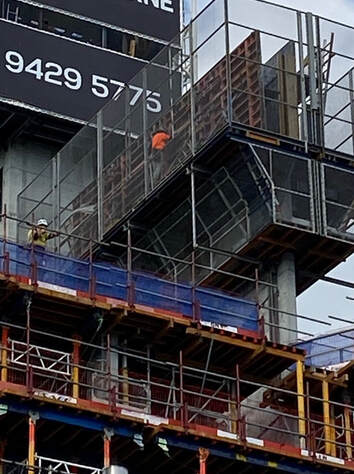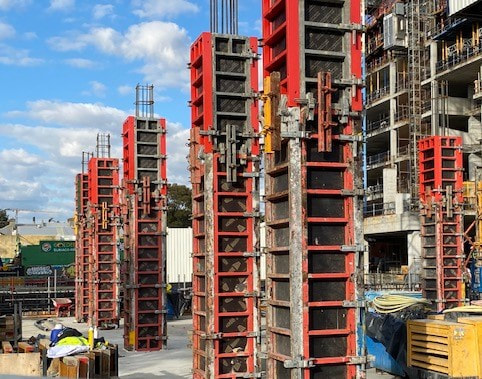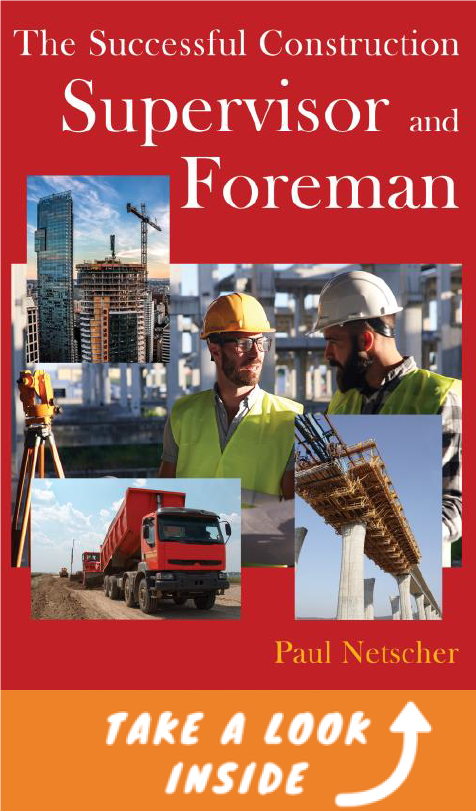|
Formwork or forms are used to retain concrete in place until it gains sufficient strength to support itself. Concrete walls and columns require formwork. Elevated concrete slabs require forms and support work to hold the concrete while it gains strength. The edges of slabs and beams require forms. Often to reach elevated areas contractors construct access scaffolding. In fact formwork and scaffolding are an integral part of many construction projects. Formwork and support work should be designed to ensure it will be strong enough to withstand and carry the weight of wet concrete, reinforcing, cast-in items, and the people and equipment used to place the concrete. The design normally assumes a rate of pour, and if this rate is exceeded it could lead to overloading of the formwork. Also materials should not be heaped on formwork, or scaffolding, since this could result in the equipment carrying a load it was not designed for. Case study: I was the Project Director on a project that involved constructing a reinforced concrete slab, two metres thick, and eight metres above an operational railway line which the supporting scaffold had to span. The support-work was designed by our Formwork Design Engineer, who also produced detailed drawings of how the support-work should be constructed. The quantity of equipment was ordered from these drawings. There was a full-time Project Manager allocated to the project, and at the time, I was responsible for five other projects, situated hundreds of kilometres apart, so I visited the project approximately every two weeks. The day before the concrete slab was due to be poured I visited another project, and at the last minute decided to make a detour on my homeward journey to check the slab was ready for the concrete. On arriving on the project site I was informed the slab was ready to receive concrete, however, I noticed a number of steel beams that had been ordered were lying unused on the ground. I queried this, and was informed the Supervisor had decided the beams were superfluous and omitted them. I contacted the Formwork Design Engineer, and explained my concerns. He immediately checked his calculations, and called me back to say he had major concerns, and was on his way to the site – some 200 kilometres from his office. When our Engineer arrived and inspected the support-work, he found the omission of the support beams meant the load of the wet concrete on the slab would not have been distributed evenly, and would have resulted in some of the scaffold support legs carrying double their load capacities. To compound the error, the Engineer found a mistake with his original calculations, which would have anyway resulted in the legs carrying an extra 20% over their capacity. This additional 20%, together with the doubling of the load, would have resulted in some scaffold legs carrying nearly two and a half times the load they were capable of carrying. If we had gone ahead with placing the concrete on the slab there is no doubt the support-work would have failed with catastrophic results, people would probably have been killed and others seriously injured, the railway would have been closed for weeks, the project would have been delayed by months, and there would have been costly property damage. As a result we postponed the concrete pour until we were able to install additional support-work to carry the load, ensuring none of the scaffold was over-loaded. There are several lessons from the above:
ConclusionFormwork that is not designed and installed correctly can result in accidents, poor quality, lost time, and even serious injury and death. Construction project managers and supervisors must ensure that formwork and access scaffolding is not damaged, which results in additional costs, and can also weaken the equipment. Never take a chance or shortcuts when installing formwork and access scaffold. Using the correct formwork installed with qualified and trained people will improve productivity and quality, while ensuring that the construction work is done safely. #constructionmanagement #formwork #scaffolding Do you want to learn how to manage construction projects successfullyTo read more about the author’s books and find out where you can purchase them visit the pages on this website by clicking the links below:
'Successful Construction Project Management: The Practical Guide' 'Building a Successful Construction Company: The Practical Guide' 'Construction Book reviews' To read more about the author visit the page 'Paul Netscher' Want to contact Paul Netscher please enter your details on 'Contacts' Find out how Paul Netscher can help you by visiting Construction Management Services Order your books from Amazon Order your books from Amazon UK © 2022 This article is not to be reproduced for commercial purposes without written permission from the author. construction management construction project management
9 Comments
I agree that support work should be designed properly to ensure sturdiness and safety. Thanks for elaborating the process and designs on how to use scaffolding in the construction of buildings. If ever that I get to manage a construction work, I will make sure that all support system like scaffolds, steel base, etc are properly installed and designed.
Reply
Paul
21/3/2019 10:13:30 am
Thanks Bree for your comments. Regrettably there are many cases each year where supportwork has collapsed under concrete slabs and where access scaffolding has fallen down - often with tragic consequences.
Reply
8/4/2021 09:14:16 pm
I want to get a project made, and I want to make sure that it's all handled right. It makes sense that getting a professional to help me out with getting the scaffolding put up right would be important. They would be able to ensure that the right calculations done.
Reply
14/4/2021 04:37:15 pm
Oh My God!!! This is a great blog, I am happy that I have come across this one. It’s an amazing blog to read, so many things about construction management blog. Thanks for this wonderful content.
Reply
9/5/2022 12:02:30 pm
Scaffolding design comes last, the framework and the efficiency for work is the priority.
Reply
13/3/2023 11:05:20 am
Scaffolding safety is a critical consideration for any building project, as it directly affects the well-being of workers and the success of the project. A robust safety plan should include measures to prevent falls, secure the scaffolding structure, and protect against other hazards. By prioritizing safety and ensuring compliance with relevant regulations and standards, construction and maintenance teams can minimize risks and ensure a successful outcome for their projects.
Reply
31/5/2023 01:12:11 pm
I recently came across your blog post discussing construction formwork and scaffolding design, and I must say, it's an excellent resource for professionals in the construction industry like myself. The article provides comprehensive insights into the importance and intricacies of formwork and scaffolding systems.
Reply
1/9/2023 08:01:18 pm
It covers essential aspects such as formwork materials, design principles, and safety considerations. The information is well-organized and suitable for construction professionals and project managers. Including real-world examples or project profiles would enhance the post's practicality.
Reply
Leave a Reply. |
Archives
June 2024
Note: We welcome genuine comments, especially comments that add additional information to the subject matter in the article. We however reserve the right to remove inappropriate comments, which includes comments that have nothing to do with the subject, comments that include inappropriate language, and comments that are an advertisement for a product or company, or which include an advertising link. Comments must be in English. We will not enter into discussion on why a particular comment was removed.
CategoriesCopyright 2016 - The attached articles cannot be reproduced for commercial purposes without the consent of the author.
The opinions expressed in the attached articles are those of the writer. It should be noted that projects are varied and different laws and restrictions apply which depend on the location of the contractor and the project. It's important that the reader uses the supplied information taking cognisance of their particular circumstances. The writer assumes no responsibility or liability for any loss of any kind arising from the reader using the information or advice contained herein. "I have what I consider some of the best books on construction management."
Books are available from: Amazon.com Amazon.co.uk takealot.com kalahari.com Amazon.in Amazon.de Amazon.fr Amazon.it Amazon.com.au Powell's Fishpond uread bokus Amazon.ca Amazon.es Other retail stores Available in paperback or on Kindle "28 YEARS OF CONSTRUCTION PROJECT MANAGEMENT EXPERIENCE, DEVELOPING SUCCESSFUL CONSTRUCTION PROJECT MANAGERS AND BUILDING SUCCESSFUL CONSTRUCTION COMPANIES"
|









 RSS Feed
RSS Feed




